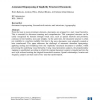Free Online Productivity Tools
i2Speak
i2Symbol
i2OCR
iTex2Img
iWeb2Print
iWeb2Shot
i2Type
iPdf2Split
iPdf2Merge
i2Bopomofo
i2Arabic
i2Style
i2Image
i2PDF
iLatex2Rtf
Sci2ools
DOCENG
2008
ACM
2008
ACM
Automated repurposing of implicitly structured documents
: From the least to most prominent elements, documents are arranged in a tacit visual hierarchy. This is essential for document scanning and comprehension. This conceptual structure can be easily recognized by humans through visual cues, such as spatial intervals and positions, contrasts in font families, sizes and weights. At the same time, the document structure is often not available in a machine readable form due to the ways documents were originally created or later transformed. This paper addresses the challenge of automatic document repurposingapplying styling and formatting from one 'implicitly' structured document to another, whilst preserving the underlying visual hierarchy. Using visual perception analysis, the proportionality mapping is established, according to which the original document content is transformed into the new style without breaking the original hierarchical structure. Spatial relationships, location and frequency analysis are then used to fine- tun...
| Added | 19 Oct 2010 |
| Updated | 19 Oct 2010 |
| Type | Conference |
| Year | 2008 |
| Where | DOCENG |
| Authors | Helen Balinsky, Anthony Wiley, Michael Rhodes, Alfie Abdul-Rahman |
Comments (0)

